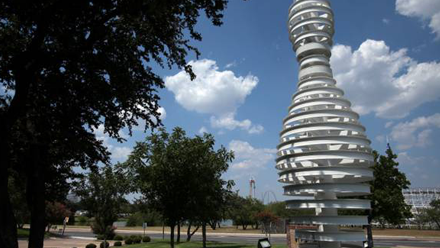
ARLINGTON — Since packing up and leaving St. Louis five years ago, the International Bowling Museum & Hall of Fame hasn’t exactly been living in the fast lane. Sitting in the shadow of some of Arlington’s biggest players — Six Flags Over Texas, Rangers Ballpark and AT&T Stadium, home of the Dallas Cowboys -- the museum drew a scant 6,000 visitors last year. Still, that's better than 2010, when 5,100 visitors toured the bowling shrine during its first year of operation in Arlington, followed by the same total the next year. The museum shut down for 18 months after leaving St. Louis. That allowed time for an international training and research facility to be built on a sprawling campus that includes the U.S. Bowling Congress and the Bowling Proprietors' Association of America, the sport's governing bodies. Slowly but surely, officials say, the multimillion-dollar campus marked with a giant bowling pin out front is winning fans -- a tough task, the museum experts say, for a "niche" museum. Even the National Baseball Hall of Fame in Cooperstown, N.Y., for example, has struggled with attendance in recent years, as have many other sports-related halls of fame.
"While we have not done the [attendance] numbers we'd like to do, we're certainly OK," said Eric Kearney, managing director of the bowling museum and hall of fame. In its last year in St. Louis, the museum attracted 27,000 visitors. But Kearney and others say it's misleading to compare attendance figures because the museum was better situation in Missouri. It sat downtown near Busch Stadium with another major tourist magnet, the St. Louis Cardinals Hall of Fame Museum. "It was a different situation," said Henry Lewczyk, vice president of marketing and business development at the Arlington Chamber of Commerce. "Here, do I think it's a well-kept secret? Yeah. But I think it's growing." Lewczyk was an executive with the Bowling Proprietors' Association when the museum and the United States Bowling Congress agreed to join the trade groups in Arlington. "There were about seven or eight cities in competition for the bowling campus," he said. Officials predict better days ahead as the museum begins cross-promoting more with sports teams and hotels in the area. It's already popular with school districts and senior citizen groups, said Anna Murphy, the museum's group coordinator.
Several people who visited the museum recently said they think it's in a good spot. Delores Peterson and her husband, Lawrence, were on a plane to Dallas talking about their passion for bowling when someone mentioned that the museum was in Arlington. The New Jersey couple visited the museum hours before a Dallas Cowboys game at nearby AT&T Stadium. "That made it easy," said Lawrence Peterson. The 18,000-square-foot museum is slightly more than a third its size in St. Louis. Yet it's more interactive than the old place, Kearney said. "Our museum has a lot more things you can touch and move around and play with than your traditional museum, where a lot of things are staged and untouchable," he said. One exhibit, called "The Future," displays the latest computer-assisted coaching techniques, tracks training trends and shows the acceleration of professional women's bowling. Kids also can get a "hands-on experience ... where the pleasure of bowling comes alive for even the tiniest child," the museum's website boasts. All in all, the bowling museum is holding its own in an era in which people increasingly are turning to the Internet and other sources to get information once gleaned in libraries, museums and halls of fame.
"Halls of fame have had some trouble lately; at least, some have," said Dewey Blanton, a spokesman for the American Alliance of Museums in Washington. Bowling "has its enduring popularity" in American culture but "it's hard for a hall of fame to attract the casual fan," Blanton said. "You really have to be a die-hard." The average attendance at American museums is "just over 27,000" visitors a year, Blanton said. "But this is really not a fair number because it includes the Smithsonian [Institute], which attracts 30 million visitors a year." Many North Texas museums far exceed the national average, too. The Sixth Floor Museum at Dealy Plaza, for instance, averages about 340,000 visitors a year, said museum spokeswoman Carol Murray. "We're pretty consistent," Murray said. In July, the Perot Museum of Nature and Science in Dallas topped a million visitors slightly more than seven months after it opened. The latest Annual Conditions of Museums and the Economy survey revealed that more people visited museums in 2012 than the year before. More than half (52 percent) reported increases in attendance. About 28 percent experienced a decline, and the remaining 20 percent held steady, the study found. The average boost in attendance was 4.3 percent, the study found.
So Kearney and other Arlington boosters are guardedly pleased with the bowling museum's double-digit percentage rise in attendance last year. The nonprofit museum is not dependent solely on visitors but also receives private donations and benefits from annual fundraisers. "We have an awareness issue in that the general public in the Dallas-Forth Worth area doesn't know the International Bowling Museum & Hall of Fame is here in Arlington," he said. "We're addressing that now."
Categories: | Tags: | Comments
(0) | View Count: (7784) |
Return